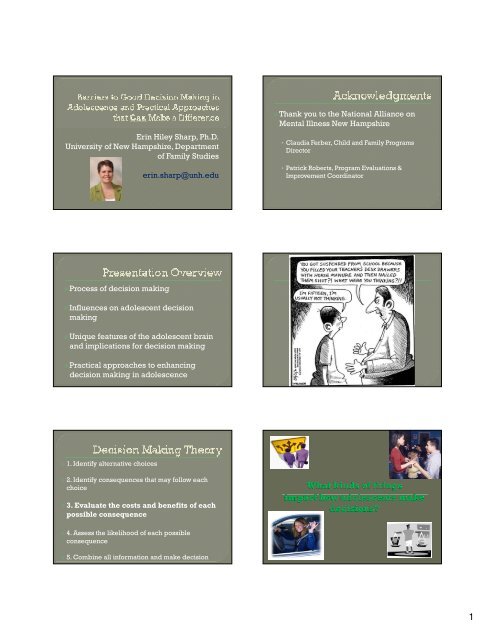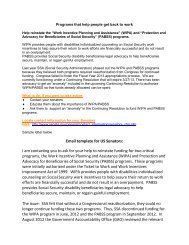Barriers to Good Decision Making in Adolescence and Practical ...
Barriers to Good Decision Making in Adolescence and Practical ...
Barriers to Good Decision Making in Adolescence and Practical ...
Create successful ePaper yourself
Turn your PDF publications into a flip-book with our unique Google optimized e-Paper software.
Er<strong>in</strong> Hiley Sharp, Ph.D.<br />
University of New Hampshire, Department<br />
of Family Studies<br />
er<strong>in</strong>.sharp@unh.edu<br />
Thank you <strong>to</strong> the National Alliance on<br />
Mental Illness New Hampshire<br />
• Claudia Ferber, Child <strong>and</strong> Family Programs<br />
Direc<strong>to</strong>r<br />
• Patrick Roberts, Program Evaluations &<br />
Improvement Coord<strong>in</strong>a<strong>to</strong>r<br />
Process of decision mak<strong>in</strong>g<br />
Influences on adolescent decision<br />
mak<strong>in</strong>g<br />
Unique features of the adolescent bra<strong>in</strong><br />
<strong>and</strong> implications for decision mak<strong>in</strong>g<br />
<strong>Practical</strong> approaches <strong>to</strong> enhanc<strong>in</strong>g<br />
decision mak<strong>in</strong>g <strong>in</strong> adolescence<br />
1. Identify alternative choices<br />
2. Identify consequences that may follow each<br />
choice<br />
3. Evaluate the costs <strong>and</strong> benefits of each<br />
possible consequence<br />
4. Assess the likelihood of each possible<br />
consequence<br />
5. Comb<strong>in</strong>e all <strong>in</strong>formation <strong>and</strong> make decision<br />
1
Individual differences (e.g., temperament)<br />
Peer <strong>in</strong>fluence<br />
Attitudes <strong>to</strong>ward risk<br />
“A tale of two bra<strong>in</strong> systems”<br />
Future orientation<br />
Bra<strong>in</strong> development<br />
“Critical period of bra<strong>in</strong> development”<br />
Major changes <strong>in</strong> bra<strong>in</strong> dur<strong>in</strong>g<br />
adolescence<br />
(1) Developments <strong>in</strong> cognitive control<br />
system (prefrontal cortex)<br />
Problem solv<strong>in</strong>g, emotional<br />
response, judgment,<br />
impulse control<br />
“Seat of civilization”<br />
• Decreases <strong>in</strong> gray matter (synaptic prun<strong>in</strong>g)<br />
• Increases <strong>in</strong> white matter (myel<strong>in</strong>ation)<br />
2
So what<br />
3
Develop<strong>in</strong>g <strong>in</strong> judgment, impulse control,<br />
<strong>and</strong> logical reason<strong>in</strong>g<br />
Reliance on other areas of the bra<strong>in</strong> for<br />
decision mak<strong>in</strong>g (amygdala)<br />
Major changes <strong>in</strong> bra<strong>in</strong> dur<strong>in</strong>g<br />
adolescence<br />
(2) Changes <strong>in</strong> socio-emotional system<br />
• Reduction <strong>in</strong> dopam<strong>in</strong>e recep<strong>to</strong>rs<br />
• Increases <strong>in</strong> oxy<strong>to</strong>c<strong>in</strong> recep<strong>to</strong>rs<br />
Dopam<strong>in</strong>e = “feel good”<br />
neurotransmitter<br />
Limbic system – pleasure<br />
center<br />
Oxy<strong>to</strong>c<strong>in</strong> “love hormone” – social bond<strong>in</strong>g<br />
What does this have<br />
<strong>to</strong> do with<br />
adolescents<br />
What does this have <strong>to</strong> do<br />
with adolescents<br />
Driven <strong>to</strong> seek sensation <strong>and</strong> novelty<br />
Influenced heavily by peers<br />
Hot/cold cognition<br />
Application: What can WE do <strong>to</strong><br />
improve the decision mak<strong>in</strong>g<br />
of adolescents<br />
4
• Surround youth with car<strong>in</strong>g adults<br />
• Include adolescents <strong>in</strong> discussions about<br />
a variety of <strong>to</strong>pics<br />
• Encourage adolescents <strong>to</strong> th<strong>in</strong>k<br />
<strong>in</strong>dependently <strong>and</strong> develop their own<br />
ideas.<br />
• Assist adolescents <strong>in</strong> sett<strong>in</strong>g their own<br />
goals <strong>and</strong> th<strong>in</strong>k<strong>in</strong>g about future.<br />
• Assist adolescents <strong>in</strong> re-evaluat<strong>in</strong>g poorly<br />
made decisions.<br />
• Reduce risks <strong>and</strong> reduce exposure <strong>to</strong><br />
potentially addictive substances<br />
New Hampshire Department of Health <strong>and</strong><br />
Human Services – Teen Resoures<br />
www.dhhs.nh.gov/foryou/teens.htm<br />
New Futures<br />
www.new-futures.org<br />
After School Alliance NH<br />
www.afterschoolalliance.org/NH_3pm.cfm<br />
4-H After School New Hampshire<br />
http://extension.unh.edu/4h/4hafschl.htm<br />
Association for M<strong>in</strong>dfulness Education<br />
www.m<strong>in</strong>dfuleducation.org/<strong>in</strong>dex/html<br />
5
Er<strong>in</strong> Hiley Sharp, Ph.D.<br />
er<strong>in</strong>.sharp@unh.edu<br />
603-862-2151<br />
6



